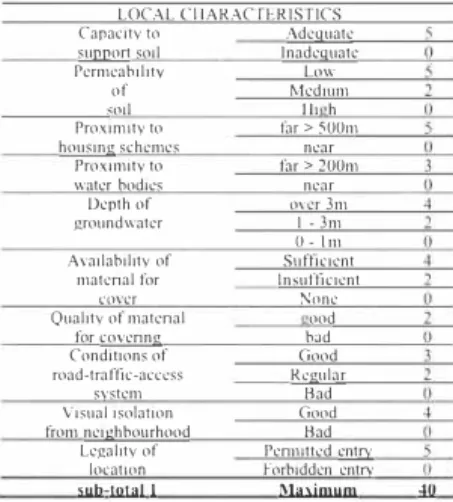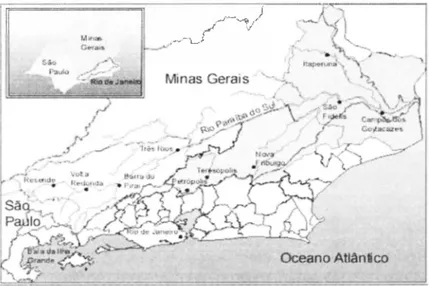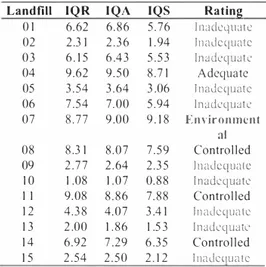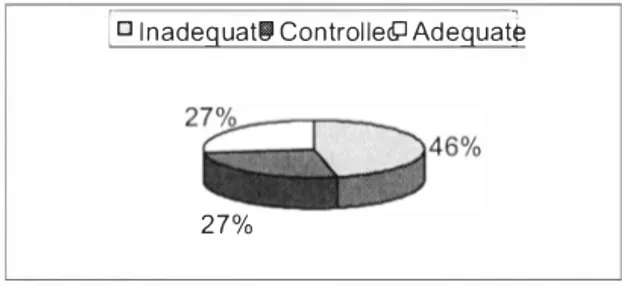QUALITY INDEX IN THE ENVIRONMENTAL
MANAGEMENT SYSTEM IN URBAN SOLID
WASTE LANDFILLS - IQS
Claudio Fernando Mahler
Saulo Machado Loureiro
Rio de Janeiro Federal University/UFRJ,Brazil
ABSTRACTThe article consists of the application of a new rating methodology for final disposal of urban solid waste (USW) by evaluating the conformity of geotechnical and environmental aspects during the implementation and operating processes. The IQS was proposed when introducing the concepts of Environmental Management, in accordance with ISO 14001, to the Landfill Quality Index (IQA) [I], developed from the Waste Quality Index (IQA) proposed by [2]. The study focused on the implementing and operating processes, as well as on the control of impacts on the environment and on pollution prevention. Fifteen sites were assessed to confirm the hypothesis. They were rated as inadequate, controlled, adequate and environmental conditions, in accordance with indices obtained with intervals between zero and ten points. It could, therefore, be concluded that in an inventory of rating USW disposal landfills, the use of ISO 14000 as an analytical tool may be extremely helpful to enhance assessment methods. Moreover, environmental management concepts contribute to reducing environmental pollution and, consequently, the associated environmental impacts.
KEYWORDS
Urban Solid Waste, Sanitary Landfill, Environmental Management, ISO 14000 I INTRODUCTION
Among the different existing environmental problems, the USW has become one of today's major challenges. The fast growing population requires the production of goods and services, which, in tum, as they are produced and consumed, generate even more waste, their collection and disposal are inadequate and cause significant impacts on public health and the environment.
Waste disposal in landfills is quite common and is the technique most used due to its practicality and low cost. However, landfills cannot be considered merely a place to store waste. They must also be assessed as geotechnical projects, with the behaviour of the different stages of implantation, operation and degradation.
Adequate disposal of USW should be conveniently designed to include concepts relating to the engineering project, knowledge of geotechniques, field investigation and laboratory studies, also covering environmental, economic, political and social aspects, and requires a team of skilled professionals [3].
Kalmar ECO-TECH '07 KALMAR, SWEDEN, November 26-28. 2007
The choice of the best site for final waste disposal is an even more complex problem, since it involves such factors as environmental, economic, transport logistics, structural safety and political [3],
[3] also find that the spaces for implementing landfills are becoming ever fewer, since, within the territorial boundaries of the counties, it is hard to choose suitable sites for disposal, which involves a thorough systematic study of various disciplines, such as Geotcchniqucs, Hydrogeology, Hydrology and Climatology.
So this article proposes a set of systematised parameters as basis for structuring and fonnulating an index relating USW, environment, health and the human being.
Considering the above factors, this proposal was based on the introduction of management
requirements, using the standard ISOl4001 (Environmental Management System
-Specification and Guidelines for use) as a criterion for adapting to the Landfill Quality Index (IQA) [I], through which the proposal is to assess final disposal and treatment of USW from the environmental management viewpoint.
Based on the hypotheses that, considering IQA rating parameters as shown in Tables I, 2 and 3, a landfill rated "adequate" (or sanitary) by IQA will not guarantee treatment and disposal of its environmentally safe waste; and that the ISO 14000 will be a valuable tool to be used in the landfill rating inventory to verify environmental conditions, as well as aspects relating to the characteristics of the site, its infrastructure and operations.
For example, a landfill with no control, collection and leachate treatment (most significant negative environmental impact) and without effective monitoring of underground water bodies, is IQ A-rated as adequate, with score 8.07.
Several underwater water pollution studies show that every uncontrolled landfill causes damage to the environment. Badly built sanitary or controlled, located or operated landfills can alter the quality of aquifers and air and, consequently, contaminate the soil, plants, animals and humans.
Next, the use of ISO 14000 is discussed as a management tool for operating USW landfills. Then the system adopted for evaluating landfills (IQS) is presented.
First, data collected on field visits from twelve USW disposal sites in the States of Rio de Janeiro, two in Sao Paulo, and one in Pernambuco, were used to apply this rating.
After applying the IQS, the rates obtained were compared analogically with the IQA [I] and IQR rates [2], With this comparison it was possible to confirm the hypothesis under consideration.
2 THE USE OF ISO 14000 IN URBAN SOLID WASTE LANDFILLS
Standard ISO 1400 I provided the necessary tools for developing the methodology, and certification requirements could be properly applied to the activities and processes of a sanitary landfill. The soil and subsoil management concept was also applied, consisting of erosion control, salinisation, desertification, proper handling of solid waste, and restoring degraded areas.
Table I: Characrerisrics ofsire [ I J
LOCAL Cl IARACTrn ISTICS Capacity 10 support soil Pcrmcab1l11v of SOL[ Proxurnty to housmg schemes Proximity to water bodies Depth of groundwater Availability of matcnal for CO\'Cf Quality of matcnal for c-ovcnng Conditions of road-traffic-access svstcm Visual 1so\a1ion from nc1ghbo11rhood Legality of locat1c-.n suh-tolill I Table l: lmpla111ed i11fi-as1ruc111re[lj
Fencing m the area Gateway/ Cabin Control of receipt 0f car o Adequate Inadequate Low Mcdmm Iii h far> 500m near far> 200111 near over 3m I -3111 0- Im S11fficicnt Insufficient None ood bad Good Rcgul.ir Bad Good Bad Pcnrnttcd entry F0rb1ddcn cntrv Muimum 40 yes /no wciohbridge no
Access at front of oood ,\·0rk had Catcrp11lar permanent tractor or penod1cal Compat1blc non-existent Other c, C UL mcnt
lmoenneab1\1ty yes, unnecessary of landfill base no
Dramagc of sufficient 5 leachate msufficient 1 non-existent 0 Defin1t1ve sufficient 4 stom1 water msufficicnt 2 drainage non-existent 0
Temoorary sufficient stonn water insufficient I
drainaoe non-existent 0 sufficient 3 Gas dramage lllSllfficient I non-existent U
Leachate. sufficient 5
treatmi:-nt system mrnfficientmon-cx1st 0
Momtonng sufficient 3
underground insufficient I
water non-existent 0
f\fon1tonng das sufficient 3 surface water. insufficient I
leachate and gases no1H�xistcnt 0 Monitoring soil sufficient 3
and waste insuffincnt 1
embankment non-existent 0
Fulfils design
st1pul<111rins art I no
Kalmar ECO-TECH '07 KALMAR, SWEDEN, November 26-28, 2007 Table 3: Working conditions[!}
OPEKA TING CONDITIONS
Presence of wind-borne No
clements VCS
Daily waste cs
cover
Waste compaction Adequate inadequate non-cx1stcnt
Presence of no
vulturcs-gulls yes
Presence of large no quantity of boulder clay yes Presence of no
humm s
Presence of 110 waste collcrtors yes
Livestock
(cattle ctr.) yes/nearby
I lcalth scn·icc waste no
dum m cs
lndustnal waste no adequate
dumping yes/inadequate
Funct1onmg Griod
leachate Regular
dra1narrc non-existent
Functioning Good definitive storm water Regular
drainage non-existent Functioning ood temporary storm water regular
dramagc non-existent
Functionin.l! ood gas drainage regular
non-cx1stcnt Function mg oood leachate treatment regular
system non-existent
Functioning ood underground water regular momtonng system non-existent Func1ionmg surface ood water. waste and gas regular
momtonno system non-existent
Functioning ood
embankment stab1l1s1ng regular
mon1tonng non-existent Corrective yes/unnecessary
measures no
General data VCS
about landfill no,incomplete Maintenance ood
of internal regular access ,·er bad Landfill shutdown \'CS
Ian no
sub-total 3 maximum 52
When administrating a solid waste sanitary landfill using an environmental management culture, committed to prevent and reduce pollution, and employing properly trained skilled manpower, it is essential to adopt an environmental management system that includes an organizational structure, planning activities, responsibilities, practices, procedures, processes and resources to comply with an established environmental policy
This system can be certified, which shows stakeholders how seriously this administration deals with the environmental question; however, ISO 14001 certification does not necessarily imply good environmental performance of the practices, processes, and compliance with the established environmental policies, as provided by ISO 14031, This standard was not used in
KALMAR, SWEDEN, November 26-28, 2007
this study, since the environmental perfomiance assessment (EPA) is only specific for each landfill, when the objective was to have a general rating for them alL
The purpose of certification is to attest that the management system can produce results but without specifying the velocity at which these results will appear. This mistaken routine may lead waste processing to polluting practices, even though the environmental management system is in operation.
3 LANDFILL ASSESSMENT SYSTEM
Not only the social but also the environmental, sanitary and public health aspects are to be considered [3], The Value Analysis Theory was therefore used [4] as a multi-criterion comparative analytical tool for the coherent converging of these variables, creating weights for the different aspects addressed, and then the Qua! ity Rating of the Environmental Management System for Urban Solid Waste Landfills (IQS) was established.
Considering the discussion herein, the standard NBR ISO 1400 I was divided into ten parameters, as follows:
L Identification of significant environmental aspects and impacts (A); 2. Objectives, goals and environmental programmes (B);
3, Guarantee of necessary resources -humans, technological and financial (C);
4. Training system -competence, consciousness -internal and external communication (D); 5. Control of SGA documents, registration (E);
6. Emergency plans and programme (F);
7. Control, monitoring and measuring of operations -relating to significant impacts (G); 8. Meeting legal and other approved requirements (H);
9, Internal audit programme (I); and
I 0. Critical analyses by the administration - considering internal audits, laws, communication, objectives, goals and environmental programmes - corrective and preventive actions -to mitigate impacts (J).
The IQS comprised four groups, the first three being taken from !QA [I] and the fourth added to the rating: Site Characteristics, Implanted Infrastructure, Working Conditions, and Environmental Management System (Table 4),
The first three groups had no alteration and the Value Analysis was therefore not applied. In the last group, when weighting the new parameters, the functions used were the ten listed above, applying the Functional Assessment Matrix (Table 5). This technique pennitted each function to be compared with the others, determining at every moment its importance by weighting between O and 3 points,
Kalmar ECO-TECH ·07
KALMAR. SWEDEN, November 26-28. 2007
Table 4: Environmental Management Assessment parameters [5}.
ENVIRONMENTAL MANAGEMENT
Identify satisfactor� 5
environmental insufficient 2 aseects and imeacts non-existent 0
Environmental consistent 3 objectives, goals inconsistent and erogrammes non-existent 0 Guarantee of sufficient 2 reg. resources. insufficient 0 Training & com. efficient 2
s�stem inefficient 0
Control of docs. es I
and records no 0
Emergency sufficient 4 programme and insufficient 2
elans non-existent 0
Control, monit. & effective 4
measurin£ of 012s. ineffective 0
Complying with es 5
legal & other regs. no 0
Internal audit satisfactorr 2
programme ineffective I
non-existent 0
Critical analyses & consistent 2 cor. & erev. action inconsistent 0 sub-total 4 Maximum 30
Table 5.· Functional Assessment Matrix [5]
B C D E F G H 1 Total % Pt A Al A3 A3 A3 0 A2 HI Al Al 14 17.073 5 B Bl B2 B2 F2 G2 H3 12 B2 7 8. 537 3 C C2 C2 Fl GI H2 Cl Cl 6 7.317 2 D D3 DI GI HI D2 12 6 7.31e7 2 E F3 G2 H3 13 E2 2 2.439 F 0 F2 F2 F2 12 14.634 4 G GI G2 G2 11 13.415 4 H H2 H2 14 17.073 5 13 5 6 098 2 1 5 6.098 2 Total 82 100.00 30
At the end of the comparison, the weights attributed to each function were added up to detennine their percentage in relation to the total weights of all functions. Following the !QA criterion of the maximum five-point scoring, the most relevant functions were given this score and the others with less proportionately.
With the development of this technique, the scoring of the parameters introduced in the IQS was successfully achieved as shown in Table 6.
KALMAR, SWEDEN, November 26-28, 2007
Table 6: Final IQS rating [5]
Total ( 1 +2+3+4) I 1 70
IQS = Sum of scores / 1 7
IQS Assessment
0 - 6.00 Inadequate conditions (landfill or dump) 6.0 1
8.00 Controlled conditions (controlled landfill) 8.01
9.00 Adequate conditions (sanitary landfill)
9.01 - I O Environmental conditions ( environmental landfill) 4 IQS APPLICATION TO LANDFILLS
The three quality indices (IQR, IQA and IQS) were applied to the 15 (fifteen) waste dumps visited. Part of the area studied among the 12 (twelve) sites visited in the State of Rio de Janeiro corresponds to the middle stretch of the Paraiba do Sul river basin (Figure I), and the rest to the Greater Rio Metropolitan Region.
The objectives for choosing these sites were: to compare the current results with those obtained previously by [I]; to present the situation in other disposal areas, in order to have a broader view of local waste management in the State of Rio de Janeiro, and to compare its reality with that of other States.
..,.f,,J•-- ) ✓
-·1-i
Figure I : Rio de Janeiro Stale and Paraiba do Sul river basin (UNDP, I 999. in [!} Faria.
7.59
Kalmar ECO-TECH ·07
KALMAR, SWEDEN, November 26-28, 2007
It was decided not to explicitly refer to the sites assessed for political-administrative questions and interests. A more detailed description of the characteristics of the case studies can be obtained in (5]e,
In the State of Rio de Janeiro, not only the population of around 2. 5 million but also 700 or so industries, various hydroelectricity plants and irrigated agriculture depend on water from this basin. In the Greater Rio Metropolitan Region, approximately eight million inhabitants are supplied from collecting 44 m'/s from the Guandu River and 5. 5 m'/s from La1es reservoir, deriving from two transpositions of the Paraiba do Sul river basin. Approximately 160 m'/s is taken directly from Paraiba do Sul River using the Santa Cecilia pumping station and 20 m'/s is used from the Pirai river basin [ I l
The assessment reports (!QR, !QA and IQS) were completed based on infonnation collected from visual inspections on the sites, some local government data, solid waste landfill operators at each site, professionals in the solid waste sector, and from consulting other reports and papers relating to these landfills.
After accomplishing all work routines, the findings were reported, converging on a weighted average, and a consensus was obtained where each parameter was graded, defining its level of satisfaction, attendance, conformity, effectiveness and/or efficiency.
The main type of soil found in most sites under study was latosoL This soil has a clay fraction of kaolinitic minerals with a high concentration of iron and aluminium. In natural conditions, it is non-saturated, with a high rate of voids and little field capacity, but when suitably compacted it can reach a high supporting capacity with low pem1eability. These characteristics make the latosol suitable material for daily covering the landfill and base layer and for impem1eability [ I l
It should also be explained that all sites were called "landfill", regardless of the rating in the assessments, in order of visits.
5 ANALYSIS OF RES UL TS
During this study, urban solid waste management models were observed in fifteen sites, whose results are given in the Table 7 below.
Table 7: Result of Landfill Quality Index Assessments [5}
Landfill IQR IQA IQS Rating
01 6. 62 6. 86 5. 76 l nackquatc 02 2.3 I 2.36 1. 94 I n adequate 03 6.15 6.43 5.53 lnadc·quatc 04 9.62 9. 50 8. 71 Adequate 05 3. 54 3. 64 3.06 I nadequate 06 7.54 7.00 5.94 lnadcquatc 07 8. 77 9.00 9.18 Environment al 08 8.31 8.07 Controlled 09 2. 77 2. 64 2.35 l n adcqualT I O 1.08 1.07 0. 88 I nadequate 11 9.08 8. 86 7. 88 Controlled 12 4.38 4.07 3.41 I n adequate 13 2.00 1. 86 1.53 l m1dcquatc· 14 6.92 7.29 6.35 Controlled 15 2. 54 2. 50 2.12 I nadcr1uatc
As can be seen, only one landfill was rated environmental and another rated adequate, which was to be expected, given the strict IQS assessment compared to !QA and !QR. Another three sites were rated controlled and the remaining ten inadequate.
From the landfill rating criteria adopted by IQA and !QR (Figure 2), 46% of the landfills assessed were rated inadequate, 27% controlled and the other 27% adequate. Now considering the IQS assessment criteria (Figure 3), the number of landfills in inadequate conditions increased to 66%, and consequently those in controlled conditions dropped to 20% and adequate to 7%, only 7% remaining rated as environmental.
Accordingly, the proposed methodology showed a 20% increase in the quantity of inadequate landfills (dumps), and a 20% drop in the number of adequate landfills (sanitary), confim1ing the hypothesis that from the previous methodologies, a landfill in adequate conditions did not necessarily maintain environmentally co1Tect operations.
From examining the following graphs, it could be said that the IQS assessment is most restrictive, since the rating in each case was lower than in the other forms of assessment, except for landfill 07, due to the SGA inserted throughout the waste treatment process and disposal, scoring in environmental parameters not assessed by the other methodologies.
I□ l nadequatgl Control le(!;] Ad equal�
27%
Figure 2: Rating by !QA and !QR [5}
al □ lnadequatell Controlle[;] Adequate□ Environme
Kalmar ECO-TECH '07
KALMAR. SWEDEN, November 26-28. 2007 6 CONCLUSIONS AND FINAL COMMENTS
Following one of the proposals for continuing the line of research on the Waste Treatment Group (GTRES) in the Geotechnics area of COPPE, the objective of this work was to evaluate the degree of confonnity of the rating criteria of USW landfills from the envieronmental management viewpoint, based on ISO 1400 I requirements, in tem1s of implementation, operation and closure of landfills, and interactions with the environment. Therefore, by applying the IQS assessment methodology in the fifteen case studies, it was possible to confirm the two hypotheses under discussion: that the IQA adequate rating does not guarantee environmentally secure USW treatment and disposal, and that NBR ISO 14001 is a valuable tool that can be used in a landfill rating inventory.
To fully attend IQS envieronmental parameters when adopting the NBR ISO 14001 requirements, it is fundamental to continue in compliance with the prevailing envieronmental laws, and to monitor and maintain previous standards of envieronmental quality, inherent in the aspects and impacts surveyed in the area next to the landfill. This tool and the other standards of the ISO 14000 family may be used to regulate waste disposal throughout Brazil.
The geotechnical parameters (support and permeability of the soil, availability and quality of cover material, compaction, drainage systems, embankment stability, remediation, closure, etc. ) were found to be important in several aspects of final waste disposal, since the landfills will inevitably be based on the ground and may be protected by it using an adequate cover. Moreover, it is of the utmost importance to guarantee envieronmental quality, proper liner compaction, groundwater depth, and penneability of the foundation soil, since this is the main route taken by liquid contaminant, namely, leachate.
Also, like water, soil is becoming ever more important especially since indiscrimienate use of spaces and borrow material for partial or final cover will be increasingly scrutinised, considering not only the envieronmental but also economic, social and financial aspects. It should be pointed out that Clean Development Mechanism (COM) concepts can and should be used in the waste sector as an economic-financial support when implementing and operating sanitary landfills, and adopting compost processes, incineration or other procedures such as drying waste, for example, to reduce greenhouse gas emissions to a minimum. Monitoring procedures, collecting and using gases can be done by burning them to generate energy. These aspects shall be included in the assessment system of midsize and large landfills in future procedures, since they are being discussed and fu11her implemented in Brazil.
Lastly, in addition to the need to use skilled personnel, with know-how and multidisciplinary experience, it must be stressed that different landfill assessment systems should be consiedered and used in accordance with their di fferent sizes. Basic aspects are similar in small, midsize and large landfills, but there are particular features inherent to the size of a landfill, which recommend major di fferences in assessment systems. Otherwise, distortions may occur since it may be impossible to adopt procedures that are absolutely possible and necessary in some other large landfill.
KALMAR, SWEDEN, November 26-28, 2007
ACKNOWLEDGEMENTS
The first author thanks CNPq, CAPES, FAPERJ and DAAD for giving their continuing support to his work, The authors thank the various local governments and their staff for their support during the field visits, and Eng, Jose Ricardo Ferreira for the technical revision of the text,
REFERENCES
[I] Faria, F, S,, 2002, indice da Qualidade de Aterros de Residuos Urbanos - !QA [Urban Waste Landfill Quality Index], M,Sc, dissertation, COPPE/UFRJ, Rio de Janeiro, Brasil;
[2] CETESB/SEMA, 2005, lnventario Estadual de Residuos S6lidos Domiciliares [State Household Solid Waste Inventory] 2004, Report, Sao Paulo, SP: Environmental Sanitation Technology Company ( C ETESB) -State Secretariat for the Environment; [3] Mahler, C, F,, Lima, G, S,, 2003, "Applying Value Analysis and Fuzzy Logic to Select
Areas for Installing Waste Fills", Environmental Monitoring and Assessment, n, 84, pp, 129-140,
[4] Csillag, J, M,, 1995, Analise do Valor -Metodologia do Valor [Value analysis -Value methodology], 4th
ed,, Sao Paulo, SP, Brasil, Editora Atlas S,A,
[5] Loureiro, S, M,, 2005, ind ice de Qualidade no Sistema da Gestao Ambiental em Ate1Tos
de Residuos S6lidos Urbanos -IQS [Quality Index in the Environmental Management
System for Urban Solid Waste Landfills], M,Sc, dissertation, COPPE/UFRJ, Rio de Janeiro, Brazil;
[6] ABNT NBR ISO 1400 I :2004, Sistemas de Gestao Ambiental - Especificayao e Diretrizes para Uso, [Environmental Management Systems - Specification and Guidelines for Use] Rio de Janeiro, RJ: Brazilian Association of Technical Standards (ABNT), December 2004, 27 p,;

![Table 5.· Functional Assessment Matrix [5]](https://thumb-eu.123doks.com/thumbv2/5dokorg/3690119.45963/6.617.243.444.119.462/table-functional-assessment-matrix.webp)


